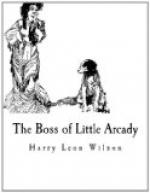“Now, Blake, this is from the grateful wretch whose life you have not only saved but enriched. Well, there’s an excellent lot of stuff there. I’ve got the pick, from a collector’s standpoint—though not from a money valuation. I can’t tell what it will bring, but enough to put our youngish old friend easy for some time to come. You box it up, as much as she wants to let go, and send it to the Empire Auction Rooms—here’s the card. They’re plain auction-room people, you understand,—wouldn’t hesitate to rob you in a genteel, auction way,—but I’ll be there and see that they don’t. Some of those other pieces I may want, but I’ll take a bidding chance on them like a man, and I’ll watch the whole thing through and see that it’s straight.”
Billy Durgin told me that Cohen and James Walsingham Price left on the night train going East. Billy noticed that Cohen seemed morose, and heard him exclaim something that sounded like “Goniff!” under his breath, as Price turned away from him after a brief chat.
For Little Arcady the appalling wonder was still to dawn. Load after load of the despised furniture went into freight-cars, until the home of Miss Caroline was only comfortably furnished. This was sensational enough—that the things should be thought worth shipping about the country with freights so high.
But after a few weeks came tales that atrophied belief—tales corroborated by a printed catalogue and by certain deposits of money in our bank to the account of Miss Caroline. That six wretched chairs, plain to ugliness, had sold for three hundred dollars spread consternation. The plain old sideboard for a hundred and ten dollars only fed the flames. But there had been sold what the catalogue described as “A Colonial sofa with carved dolphin arms, winged claw feet, and carved back” for two hundred and ten dollars, and after that the emotions aroused in Little Arcady were difficult to classify. Upon that very sofa most of the ladies of Little Arcady had sat to pity Miss Caroline for being “lumbered” with it. Again, a “Colonial highboy, hooded,” recalled as an especially awkward thing, and “five mahogany side chairs” had gone for three hundred and eighty dollars. A “Heppelwhite mahogany armchair,” remembered for its faded red satin, had veritably brought one hundred and sixty dollars; and a carved rosewood screen, said to be of Empire design, but a shabby thing, had sold astonishingly for ninety dollars. A “Hogarth chair-back settee” for two hundred and ten dollars, and “four Hogarth side chairs” for three hundred and fifteen dollars only darkened our visions still further. Some of us had known that Hogarth was an artist, but not that he had found time from his drawing to make furniture. Of Heppelwhite we had heard not at all, although twelve arm-chairs said to be his had been by some one thought to be worth around seven hundred dollars. Nor of any Sheraton did we know, though one of his sideboards and a “pair




